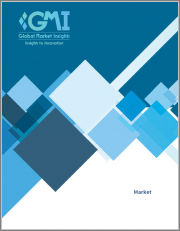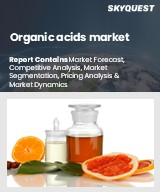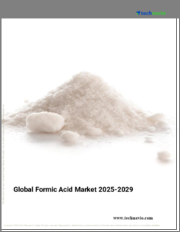
|
시장보고서
상품코드
1396550
세계 포름산 시장 - 등급별, 용도별 예측(2023-2032년)Formic Acid Market - By Grade (20%, 25%, 40%, 60%, 70%, 75%, 85%, 90%, 94%, 99%), By Application (Leather & textile processing, Agriculture, Animal Feed, Cleaning, Coating, Rubber, Intermediate) & Forecast, 2023 - 2032 |
||||||
포름산 세계 시장은 2023년부터 2032년까지 CAGR 5.1%를 기록할 것으로 예상됩니다.
포름산의 용도는 기존 분야에 그치지 않고 발전에도 중요한 역할을 하고 있습니다. 산업계가 보다 깨끗한 대체물질을 선호하는 가운데 포름산은 다양한 공정에서 지속가능한 선택으로 등장하여 보다 환경친화적인 미래에 기여합니다. 이 화합물의 환경 친화적 인 특성은 다양한 산업에서 환경 친화적 인 실천을위한 세계의 노력과 일치하고 시장 성장을 견인하는 중요한 선수로 자리 매김 될 것으로 보입니다.
각 기업은 포름산을 통해 지속 가능한 솔루션을 적극적으로 혁신하고 개척하여 시장 성장에 기여하고 있습니다. 이러한 지속가능성에 대한 주력은 포름산산업의 회복력과 경쟁력을 높이고 있습니다. 예를 들어 2023년 AIST의 연구자는 쓰쿠바대학과 공동으로 유동형 반응시스템을 통해 포름산으로부터 생성되는 수소를 이용하는 발전시스템을 구축했습니다.
포름산 시장 규모는 등급, 용도 및 지역에 따라 분류됩니다.
90% 등급의 부문은 농업, 섬유, 고무 제조 등 다양한 산업에서의 용도가 넓기 때문에 2023년부터 2032년에 걸쳐 현저한 성장을 보인다고 생각됩니다. 90% 등급은 포름산 농도가 높기 때문에 효능이 높고 다양한 산업 공정에 적합합니다. 산업계가 점점 효율성과 성능을 우선시하고 있는 가운데, 90% 등급의 분야는 그 광범위한 유용성과 다방면에 대한 영향에 의해 두드러진 존재가 될 것으로 보입니다.
가축의 성능과 건강을 향상시키기 위한 고품질 사료 첨가물에 대한 수요가 증가함에 따라, 동물사료 응용 분야는 2032년까지 현저한 포름산 시장 점유율을 달성할 것입니다. 동물사료에서 강력한 방부제와 산미료로서 포름산의 역할은 소화와 전반적인 건강에 긍정적인 영향을 미치고 그 확산을 촉진합니다. 동물 영양학에 대한 관심 증가와 지속가능한 농업의 추구는 동물사료 분야에서 포름산의 중요성을 더욱 높이고, 그 중요한 역할을 확고하게할 것으로 보입니다.
아시아태평양의 포름산산업은 역동적인 경제 성장, 견조한 산업화, 농업 등의 분야에서의 용도 확대에 의해 2023년부터 2032년까지 주목할 만한 CAGR로 성장하고 있습니다. 인구 증가와 도시화 동향은 포름산 기반 제품에 대한 요구를 더욱 증가시키고 아시아태평양을 업계 상황을 형성하는 매우 중요한 힘으로 확립하고 있습니다. 이 지역의 다양하고 확대되는 시장이 포름산 수요의 상승을 견인하고 있으며 세계 시장 시나리오에서 APAC의 영향력과 경제력의 높아짐을 반영하고 있습니다.
목차
제1장 조사 방법과 조사 범위
제2장 주요 요약
제3장 포름산업계 인사이트
- 생태계 분석
- 업계에 미치는 영향요인
- 성장 촉진요인
- 업계의 잠재적 위험 및 과제
- 잠재성장력 분석
- COVID-19의 영향 분석
- 규제 상황
- 미국
- 유럽
- 가격 분석 - 2022년
- 상환 시나리오
- 기술 전망
- 향후 시장 동향
- GAP 분석
- Porter's Five Forces 분석
- PESTEL 분석
- 러시아-우크라이나 전쟁의 영향
제4장 경쟁 구도
- 소개
- 기업 매트릭스 분석
- 세계 기업 점유율 분석
- 경쟁 포지셔닝 매트릭스
- 전략 대시보드
제5장 포름산 시장 규모 및 예측 : 등급별(2018-2032년)
- 20%
- 25%
- 40%
- 60%
- 70%
- 75%
- 85%
- 90%
- 94%
- 99%
제6장 포름산 시장 규모 및 예측: 용도별(2018-2032년)
- 피혁 및 섬유 가공
- 농업
- 동물사료
- 가금
- 돼지
- 반추동물
- 수생
- 세정
- 코팅
- 고무
- 중간
제7장 포름산 시장 규모 및 예측 : 지역별(2018-2032년)
- 주요 동향 : 지역별
- 북미
- 미국
- 캐나다
- 유럽
- 독일
- 영국
- 프랑스
- 스페인
- 이탈리아
- 아시아태평양
- 일본
- 중국
- 인도
- 호주
- 한국
- 인도네시아
- 말레이시아
- 라틴아메리카
- 브라질
- 멕시코
- 아르헨티나
- 중동 및 아프리카
- 남아프리카
- 사우디아라비아
- 아랍에미리트(UAE)
- 이집트
제8장 기업 프로파일
- BASF SE
- Eastman Chemical Company
- Perstorp
- Feicheng Acid Chemicals Co., Ltd.
- Chongqing Chuandong Chemical(Group) Co., Ltd.
- Gujarat Narmada Valley Fertilizers & Chemicals Limited(GNFC)
- LUXI GROUP
- Kamdhenu Chemicals
- Thana Acid and Chemical Company
- Navin Chemicals
Global Formic Acid Market will register a 5.1% CAGR from 2023 to 2032, propelled by an increasing emphasis on sustainability and eco-friendly solutions. Its versatile applications extend beyond traditional sectors, finding a pivotal role in power generation. As industries prioritize cleaner alternatives, formic acid will emerge as a sustainable choice for various processes, contributing to a greener future. The compound's eco-friendly attributes will position it as a key player in driving the market's growth, aligning with global efforts towards environmentally responsible practices in diverse industries.
Organizations are actively innovating and developing sustainable solutions through formic acid, contributing to market growth. This sustainable focus enhances the formic acid industry's resilience and competitive standing. For instance, in 2023, in partnership with the University of Tsukuba, a researcher at AIST created a power generation system that utilizes hydrogen produced from formic acid through a flow-type reaction system.
The formic acid market size is classified based on grade, application, and region.
The 90% grade segment will garner notable gains between 2023 and 2032 due to the segment's versatile applications across various industries, including agriculture, textiles, and rubber manufacturing. The higher concentration of formic acid in the 90% grade ensures greater efficacy, making it a preferred choice for diverse industrial processes. As industries increasingly prioritize efficiency and performance, the 90% grade segment will stand out, driven by its widespread utility and impact across multiple sectors.
The animal feed application segment will achieve remarkable formic acid market share by 2032, driven by the escalating demand for high-quality feed additives to enhance livestock performance and health. Formic acid's role as a potent preservative and acidifier in animal feed positively impacts digestion and overall well-being, fostering its widespread adoption. The increasing focus on animal nutrition and the pursuit of sustainable farming practices will further amplify the significance of formic acid in the animal feed segment, solidifying its pivotal role.
Asia-Pacific formic acid industry will grow at a noteworthy CAGR from 2023 to 2032, attributed to dynamic economic growth, robust industrialization, and increased applications in sectors like agriculture. Rising populations and urbanization trends further amplify the need for formic acid-based products, establishing Asia-Pacific as a pivotal force in shaping the industry landscape. The region's diverse and expanding markets drive the ascendancy of formic acid demand, reflecting the growing influence and economic prowess of APAC in the global market scenario.
Table of Contents
Chapter 1 Methodology & Scope
- 1.1 Industry coverage
- 1.2 Market scope & definition
- 1.3 Base estimates & calculations
- 1.3.1 Data collection
- 1.4 Forecast parameters
- 1.5 COVID-19 impact analysis at global level
- 1.6 Data validation
- 1.7 Data Sources
- 1.7.1 Primary
- 1.7.2 Secondary
- 1.7.2.1 Paid sources
- 1.7.2.2 Unpaid sources
Chapter 2 Executive Summary
- 2.1 Formic Acid industry 360 degree synopsis, 2018 - 2032
- 2.2 Business trends
- 2.3 Grade trends
- 2.4 Application trends
- 2.5 Regional trends
Chapter 3 Formic Acid Industry Insights
- 3.1 Industry ecosystem analysis
- 3.2 Industry impact forces
- 3.2.1 Growth drivers
- 3.2.2 Industry pitfalls & challenges
- 3.3 Growth potential analysis
- 3.3.1 By function
- 3.3.2 By end-use
- 3.4 COVID- 19 impact analysis
- 3.5 Regulatory landscape
- 3.5.1 U.S.
- 3.5.2 Europe
- 3.6 Pricing analysis, 2022
- 3.7 Reimbursement scenario
- 3.8 Technology landscape
- 3.9 Future market trends
- 3.10 GAP analysis
- 3.11 Porter's analysis
- 3.12 PESTEL analysis
- 3.13 Impact of Russia Ukraine war
Chapter 4 Competitive Landscape, 2022
- 4.1 Introduction
- 4.2 Company matrix analysis, 2022
- 4.3 Global company market share analysis, 2022
- 4.4 Competitive positioning matrix
- 4.5 Strategy dashboard
Chapter 5 Formic Acid Market Size and Forecast, By Grade 2018 - 2032
- 5.1 20%
- 5.2 25%
- 5.3 40%
- 5.4 60%
- 5.5 70%
- 5.6 75%
- 5.7 85%
- 5.8 90%
- 5.9 94%
- 5.10 99%
Chapter 6 Formic Acid Market Size and Forecast, By Application 2018 - 2032
- 6.1 Leather & textile processing
- 6.2 Agriculture
- 6.3 Animal Feed
- 6.3.1 Poultry
- 6.3.2 Swine
- 6.3.3 Ruminants
- 6.3.4 Aquatic
- 6.4 Cleaning
- 6.5 Coating
- 6.6 Rubber
- 6.7 Intermediate
Chapter 7 Formic Acid Market Size and Forecast, By Region 2018 - 2032
- 7.1 Key trends, by region
- 7.2 North America
- 7.2.1 U.S.
- 7.2.2 Canada
- 7.3 Europe
- 7.3.1 Germany
- 7.3.2 UK
- 7.3.3 France
- 7.3.4 Spain
- 7.3.5 Italy
- 7.4 Asia Pacific
- 7.4.1 Japan
- 7.4.2 China
- 7.4.3 India
- 7.4.4 Australia
- 7.4.5 South Korea
- 7.4.6 Indonesia
- 7.4.7 Malaysia
- 7.5 Latin America
- 7.5.1 Brazil
- 7.5.2 Mexico
- 7.5.3 Argentina
- 7.6 MEA
- 7.6.1 South Africa
- 7.6.2 Saudi Arabia
- 7.6.3 UAE
- 7.6.4 Egypt
Chapter 8 Company Profiles
- 8.1 BASF SE
- 8.2 Eastman Chemical Company
- 8.3 Perstorp
- 8.4 Feicheng Acid Chemicals Co., Ltd.
- 8.5 Chongqing Chuandong Chemical (Group) Co., Ltd.
- 8.6 Gujarat Narmada Valley Fertilizers & Chemicals Limited (GNFC)
- 8.7 LUXI GROUP
- 8.8 Kamdhenu Chemicals
- 8.9 Thana Acid and Chemical Company
- 8.10 Navin Chemicals



















